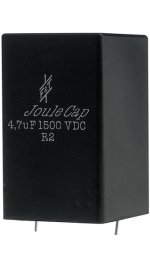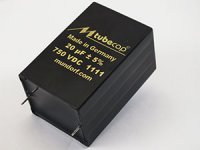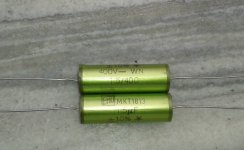Just read this..its always interesting to listen to others struggle..
The Grounded Grid preamplifier
It would be interesting if anyone else has listened to Janzen Z Caps and Janzen silver Z caps what if any difference did you find..the reason I ask is
they are quite close in price..
I have just put some Z caps in a line stage ...I guess they are OK..but not close to others I have used..
This Vs This?
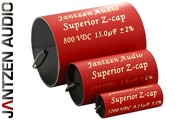
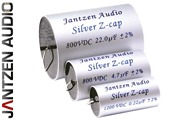
Regards
M. Gregg
Last edited:
When someone says he has a grounded grid audio stage it is extremely likely that he doesn't have grounded grid, but cathode coupled - what I call a short tail pair. The second grid (which could be grounded) is often used for feedback so is not grounded.
Interesting that when he made arrangements to quickly switch between capacitors he could not hear anything. Assuming he doesn't mean that the music became inaudible he may mean that when tested under conditions which provided the short term memory needed for such tests, he could detect no difference.
The caps he used are sufficiently different in physical size (although all rather large) and exact mounting location that hum/RF pickup could be a significant factor in whatever genuine sound difference there was.
Interesting that when he made arrangements to quickly switch between capacitors he could not hear anything. Assuming he doesn't mean that the music became inaudible he may mean that when tested under conditions which provided the short term memory needed for such tests, he could detect no difference.
The caps he used are sufficiently different in physical size (although all rather large) and exact mounting location that hum/RF pickup could be a significant factor in whatever genuine sound difference there was.
Interesting that when he made arrangements to quickly switch between capacitors he could not hear anything. Assuming he doesn't mean that the music became inaudible he may mean that when tested under conditions which provided the short term memory needed for such tests, he could detect no difference.
The caps he used are sufficiently different in physical size (although all rather large) and exact mounting location that hum/RF pickup could be a significant factor in whatever genuine sound difference there was.
Yes,
I found that interesting,
There are some interesting points in the link..The RF impact is a definite issue and the effect "open circuit" that capacitors create. Pick up..
I think it is an interesting issue in cable construction as well.
The problem that a ground connection is quieter until the mains earth is connected..
Regards
M. Gregg
NB,
Its interesting that Jensen capacitors create the same capacitor and just change the material the tube is made of and get a sound change..
What is this saying about audio capacitors?
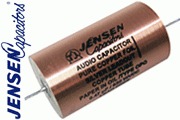
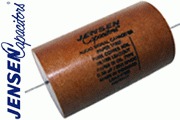
I shield my capacitors which obviously has an effect..however the phenolic tube is supposed to be better...Is it because its insulating or because its non conductive or other? Are the capacitors acting like a microphone...The tight winding of capacitors..Janzen is supposed to be very tight..
If and its an If transformers using silver in the output winding have a different sound is this reflected in the operation of capacitors..as opposed to conductors..
Regards
M. Gregg
Its interesting that Jensen capacitors create the same capacitor and just change the material the tube is made of and get a sound change..
What is this saying about audio capacitors?


I shield my capacitors which obviously has an effect..however the phenolic tube is supposed to be better...Is it because its insulating or because its non conductive or other? Are the capacitors acting like a microphone...The tight winding of capacitors..Janzen is supposed to be very tight..
If and its an If transformers using silver in the output winding have a different sound is this reflected in the operation of capacitors..as opposed to conductors..
Regards
M. Gregg
Last edited:
When someone says he has a grounded grid audio stage it is extremely likely that he doesn't have grounded grid, but cathode coupled - what I call a short tail pair. The second grid (which could be grounded) is often used for feedback so is not grounded.
Interesting that when he made arrangements to quickly switch between capacitors he could not hear anything. Assuming he doesn't mean that the music became inaudible he may mean that when tested under conditions which provided the short term memory needed for such tests, he could detect no difference.
The caps he used are sufficiently different in physical size (although all rather large) and exact mounting location that hum/RF pickup could be a significant factor in whatever genuine sound difference there was.
It's funny because I was just reading some articles on Tubecad that specifically talk about how the design by Transcendant Sound is not actually a grounded grid circuit. I also read about did much reading (mostly on Tubecad) on cathode follower power amp circuits and I realized the Cathode Follower by Transcendent Sound is not actually a cathode follower either (I have his schematic and have built that amp). Makes me think that the designer Bruce Rozenblit doesn't really know his circuits very well (despite what his inflated ego would have you believe).
On a more related note, I have tried the Superior Z caps and they work quite well, but I haven't tried the silver, though if you can get them for a similar price, why not try it? It certainly would not sound bad.
NB,
Its interesting that Jensen capacitors create the same capacitor and just change the material the tube is made of and get a sound change..
What is this saying about audio capacitors?


I shield my capacitors which obviously has an effect..however the phenolic tube is supposed to be better...Is it because its insulating or because its non conductive or other? Are the capacitors acting like a microphone...The tight winding of capacitors..Janzen is supposed to be very tight..
If and its an If transformers using silver in the output winding have a different sound is this reflected in the operation of capacitors..as opposed to conductors..
Regards
M. Gregg
Jensen caps are quite expensive, and not really worth it IMO. I have found I like the ones by Jupiter better, though I have only tried the aluminum foil in my Aikido 6SN7 linestage. I'm willing to bet the copper foils are even better than that as well.
A physically large cap is likely to interact more with both the ambient EM fields (mainly the electric field) but also with ambient sound fields. Hence it is more likely that large caps will change their 'sound' when some detail of construction is changed. This is not a sign of excellence (e.g. 'fine discrimination') but a warning that caps should not be too large.
On the other hand, caps should not be too small. Small means thin dielectric (and so high electric field) or high permittivity dielectric. Both tend to lead to non-linearity.
On the other hand, caps should not be too small. Small means thin dielectric (and so high electric field) or high permittivity dielectric. Both tend to lead to non-linearity.
Jensen caps are quite expensive, and not really worth it IMO. I have found I like the ones by Jupiter better, though I have only tried the aluminum foil in my Aikido 6SN7 linestage. I'm willing to bet the copper foils are even better than that as well.
Hi Nailbunny7,
I have used the Jupiter caps they sound very good, however high temperatures can be an issue...I like the Robert Hovland SuperCap it sounds like the Jupiter but it doesn't melt..
I have also used the Audyn true copper, however you have to be very careful it is very revealing..perhaps too revealing..it sounds very similar to the old Audio note copper and oil..
After listening last night to the Janzen they aren't bad..The bass extension on the "red Z" is very good..it has the polypropylene warm sound..I guess they are useful where you need higher values of uF (they are quite compact and not to expensive) I haven't tried the Z silver, the reports of a top end Flair put me off..
I think the Red Z is better than the obbligato..its a personal thing the obbligato reminds me of sitting in the smoking room of a large venue..
Club house sound..
Regards
M. Gregg
Last edited:
On the other hand, caps should not be too small. Small means thin dielectric (and so high electric field) or high permittivity dielectric. Both tend to lead to non-linearity.
I think the problem is that caps like LCR etc sound very good, however when you listen to something like the Janzen you can't help but ask questions and these are quite cheap a 0.1uf is about £5.00..1200v working..
Give a couple a go and see what you think..
Regards
M. Gregg
£5 for a 0.1uF cap is not cheap.
That's true, you can get a Panasonic cap for 0.50 usd, which is cheaper, but I don't mind spending a bit more on boutique parts if the budget allows. I usually allow myself a decent budget for a given project, so there is room to try different things and see if it makes a notable difference.
£5 for a 0.1uF cap is not cheap.
The idea was that its cheap compared to boutique parts..
You can get a 0.1 for 50p..
Compared to the phenolic Jensen £46.00 for a 0.1uF
You could probably buy all the passives for a build..£5.00..I'm not saying you shouldn't..I would probably use orange drop caps..or LCR non audio which I think are better than the audio version..
However the discussion was with the link..
NB this isn't to get people to go and buy expensive parts its just a discussion..
However you can use an old BSR turntable you don't have to by a Linn Sondek..(The space deck was better)..
Regards
M. Gregg
Last edited:
Ok, so when you said £5 is
As I keep saying, in several different contexts, it is easy to make something sound different - just degrade the sound a little. Not too much, as people might notice. Harder to improve something which is already good enough.
you actually meant "expensive, but not as hideously expensive as £46".M Gregg said:quite cheap
As I keep saying, in several different contexts, it is easy to make something sound different - just degrade the sound a little. Not too much, as people might notice. Harder to improve something which is already good enough.
Ok, so when you said £5 is cheap
you actually meant "expensive, but not as hideously expensive as £46".
Correct..
The cheaper end of expensive..
Regards
M. Gregg
Last edited:
After reading the Link again,
I have never heard of the TRAM WOT<<
So I did a search and I assume this is it possibly from the same person..(Has anyone tried this?)
TRAM w.
And..
http://www.troelsgravesen.dk/wot.htm
NB there are a few problems shown in the Hum department however its an interesting read..I notice Mr Broskie has an input..
Regards
M. Gregg
I have never heard of the TRAM WOT<<
So I did a search and I assume this is it possibly from the same person..(Has anyone tried this?)
TRAM w.
And..
http://www.troelsgravesen.dk/wot.htm
NB there are a few problems shown in the Hum department however its an interesting read..I notice Mr Broskie has an input..
Regards
M. Gregg
Last edited:
£5 for a 0.1uF cap is not cheap.
Agree.
Btw. Which of thse caps do you think is more expensive? Ignore the values - these are just sample pictures.. You can get both for 20uF and rated to 750VDC... They have exactly same physical dimensions as well.. Do you think there is any difference between them? They are made in the same factory too, and have exactly the same specs...
Still not certain? check it out for yourself!
They are both very decent caps. But I pick the cheaper one.
Attachments
Last edited:
Agree.
Btw. Which of thse caps do you think is more expensive? Ignore the values - these are just sample pictures.. They can be both 20uF and rated to 750VDC... Have exactly same physical dimensions as well Do you think there is any difference between them? They are made in the same factory too, and have exactly the same specs... check it out for yourself!
They are both very decent caps. But I pick the cheaper one.
Yep, and the cheaper one is rated for high voltages, which is nice. Though those are for power supplies, right? I usually just use electrolytics bypass with smaller film caps, though, if I have a large budget I may use some big film caps, such as the ones made by Solen, which go up to 220uf.
Agree.
Btw. Which of thse caps do you think is more expensive? Ignore the values - these are just sample pictures.. You can get both for 20uF and rated to 750VDC... They have exactly same physical dimensions as well.. Do you think there is any difference between them? They are made in the same factory too, and have exactly the same specs...
Still not certain? check it out for yourself!
They are both very decent caps. But I pick the cheaper one.
The only place I even really care about using nice caps is on the output of the circuit usually.
The only place I even really care about using nice caps is on the output of the circuit usually.
I use nice caps in every place I can. Just don't spend much money on them.
For example these are excellent. Much cheaper than solen or the crazy expensive botique stuff. If your circuit is well designed then the components don't need to be posh.
Attachments
Last edited:
- Status
- This old topic is closed. If you want to reopen this topic, contact a moderator using the "Report Post" button.
- Home
- Amplifiers
- Tubes / Valves
- Just for interest
